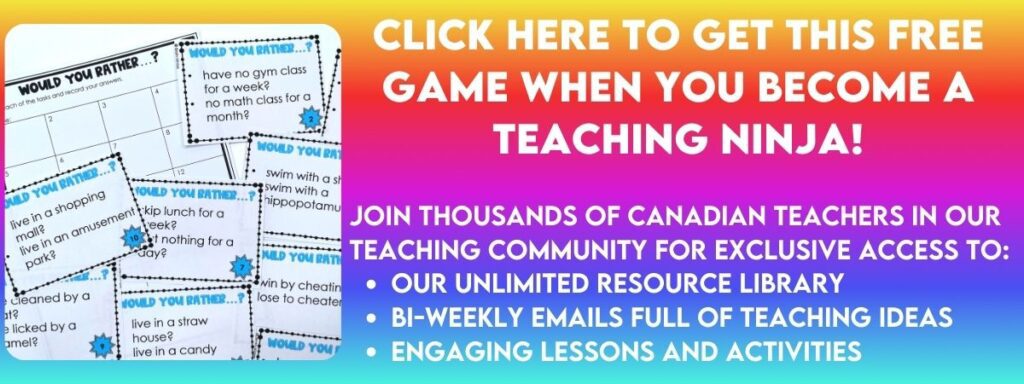
Recently I was having a discussion with a former student teacher. She had reached out because her last school year felt like a disaster and she was wondering how could improve. She’d tried clip charts, behaviour charts, communication journals, reward baskets and everything else she could think of, but nothing worked. She wanted to know how she could improve her classroom management because she feared she couldn’t last another year. She asked about my secret because she didn’t remember what I did.
Was it that uneventful that she didn’t know what I did? No. Not quite.
I told her she didn’t actually have a classroom management plan. That would imply she was in charge of her room and had a plan. So, after a few cups of coffee, we managed to work out a real plan that she thought she could handle.
First of all, we don’t use any charts or reward systems in our classroom. We don’t use Class Dojo or any other point system. These might work for some teachers, but in our experience, we’re just not careful enough about the points and then we lose interest and it falls apart, so ten years ago we stopped with all the classroom management games and tried something else.
We tried just managing the classroom as if they were a group of humans who needed to cohabit in a classroom together for ten months. And it worked. We didn’t “manage” our students. We taught them to manage themselves.
The Key to Classroom Management in Seven Steps

Start on Day One
Classroom management starts the moment you meet your students. Your tone sets their tone. The volume level of your voice indicates how loud it should be. Your wait time indicates how long they’ll wait.
So, if you want your students to come into the room calm and ready to work, model this. Speak quietly, greet them and get straight to work. If they aren’t ready, stare them down and wait.
The first time I waited for science class it took eighteen minutes for every student to be sitting down with their materials, quiet and ready to listen. When it finally calmed down, I explained that my students shouldn’t need more than three minutes to come in from recess, get their materials and be ready to work.
The next day I stared at them until they were ready. It took five minutes. I reminded them that the expectation was three minutes.
The day after that I set a three-minute timer and watched to see what happened. Every single student was in place for two minutes and forty-one seconds. I took the class outside for recess five minutes early as a reward for exceeding my expectations. I did not wait for the class to be ready again for the majority of the year.
Of course, we always have to review the expectations after breaks or when the schedule gets tossed around for special events, but those eighteen minutes of wait time on the first lesson pay off for the rest of the year.
Expectations Instead of Rules
Having a long list of rules for students to have to follow is just going to result in disappointment. We don’t actually have “rules” in our classroom. We have expectations for what we want our students to do, how we want them to act and how we want them to handle the situation when they mess up (because they will mess up-no one is perfect).
At the very beginning of the year, we explain expectations as they arise. Are we headed outside for recess? We remind students we expect students to walk quietly in the hall, throw their trash in the garbage or stay inside the school grounds. This isn’t a rule-setting forum, but we have a simple conversation with the whole class and talk about what we all expect.
More importantly, we talk about how we want students to respond if they or someone else makes a mistake. We don’t encourage tattling, instead, we talk about different scenarios and then role-play how we want students to act. Right from the beginning of the year, we ask our students to look out for each other and be a team. Team members help each other-they don’t look for ways to get their friends into trouble.
We use our Expected and Unexpected Behaviours unit to work with our students. It is so important to break stereotypes with your students-especially those ones that have traditionally been the class trouble maker. Those are the students you want to gain trust with right from the get go. Find Expected and Unexpected Behaviours for Upper Elementary in our TpT Store ($USD) or BN Shop ($CAN). Find Expected and Unexpected Behaviours for Lower Elementary in our TpT Store ($USD) or BN Shop ($CAN).
Expectations are different from rules because they focus on typical behaviours in certain situations: classroom, social and in the community. It is a great opportunity to talk about norms and how to respond when the norm is something more uncommon or something we don’t know about.
When a student breaks from what we want them to do, we don’t ask about a rule, we simply say, “What is the expectation right now?” And usually, that is enough to get a student back on track-once everything is in place.
Rules are just invitations to push the envelope. Some kids thrive on breaking them, so don’t set yourself up for failure in the first place. Rules imply a punishment for breaking them, whereas expectations allow for redirection.
We teach our students a list of courtesies so they feel empowered in our classroom. You can read about them in our post How to Save Your Sanity In the Classroom.
Consistency Always
If you flip-flop on your expectations then students will pick up on this and you’ll lose any momentum you’ve gained. Now, this is different than differentiating for students. Inconsistency comes when we’re tired or we’ve given up and that’s when your students will turn.
Use natural consequences when possible. For example, if you’ve asked students to work quietly but Little Mark keeps chatting away, give him a warning that if he talks again you’re going to relocate him. When he talks again, move him. Do what you say you’ll do.
Some students might need more or fewer warnings, but the main idea is that you always do what you say-so don’t make empty threats or promises. Keep consequences simple and appropriate for the indiscretion.
Use Proximity

Move around the classroom all the time! Don’t stay perched somewhere during your lessons. Your students will learn your movement patterns so keep them on their toes by mixing it up. Once they learn you will always be checking over their shoulder, they are less likely to try to do something inappropriate.
Students can also be moved. If you have a chatty student move them closer to you and talk to them directly. Sometimes that’s all it takes to keep students on track.
Proximity also matters in what and how you are teaching. If your lessons are not challenging or engaging, you’re going to have more challenging behaviours.
Frustration can also cause behaviour problems, so it’s important to know the best way your students learn and how challenging the material needs to be in order for them to flourish.
Reward Exceptional-Not the Expected

This might sound counterproductive but don’t reward the behaviour you expect. Thank students for it and acknowledge it, but only reward behaviour that exceeds your expectations.
For example, if you expect students to work quietly for ten minutes while you work with a small group and then you actually work without any interruptions for fifteen minutes, be sure to reward the class with praise and maybe even a few extra minutes of “free” time.
When you reward the expected behaviour, it doesn’t allow students to strive for exceptional. Your expectations should be the basic norms for any classroom.
Keep the rewards simple and use an interval. This means at the beginning of the year reward the exceptional behaviour a few times a day for a week. Then change to once or twice a day for a week. Keep reducing the interval until it’s very random. This way students will strive to exceed the expectations.
Relationships Matter
Time invested in your students will be paid back in huge rewards later. Get to know them: likes and dislikes, hobbies and favourite sports teams. Use this information to craft your lessons, to start conversations, or just to connect.
When a student messes up and gets in trouble, instead of lecturing them, try talking to them like a human first. You can get to the whole “I’m in trouble because…” part later. Your student needs to know that regardless of what they do wrong, they are still important to you and you still care about them unconditionally.
Students misbehave for a variety of reasons. If they are needing more attention, you can be proactive by spending quality time with them when they are not in trouble. In fact give them as much attention as you can when they are doing things right. Invite students to spend time with you when they are doing things well.

When students fear failure they can act out or freeze-not getting any of their work done. Even adults can suffer from this disabling need to be perfect, so it’s important to be nurturing rather than accusatory. Students need to feel as though their classroom is a safe place to take learning risks. When students lack self-confidence, your role should be to put them in situations where they will be successful to gain some confidence.
Some students act out because they are dealing with cultural differences. This happens often with children coming from trauma situations. They will occasionally react to situations with violence, but knowing this can help diffuse potential situations before they arise.
Students who thrive on power can be a challenge, especially if you engage in a power struggle. We’ve often found these students thrive in a situation where they can be in charge in a productive way. We often get these students to lead other students or younger students in such a way that we coach them into using all that power to be a good leader. Some leaders need a little more coaching than others, but generally, these students learn to relinquish some of the power and start using it for good.
Take time to chat with your students. We start our year with activities that encourage our students to talk with each other, like this Would You Rather…? game.
Relationships between your students also matter. They need to know they are a community. Want to learn more about how you can create a sense of agency in your classroom and teach your students to manage themselves? Check out this post: Creating a Sense of Agency.
Make every child feel like they are your favourite.
Pick Your Battles
While it’s important to be consistent, know when to pick your battles. Sometimes the issue isn’t worth blowing up the entire lesson, but sometimes you need to die on that hill.
This is where knowing your students comes in. Some of your students will need more time to adjust to your management style and expectations, but they’ll get there when they know you’re not going to nit-pick every single little thing they do wrong.
Sometimes ignoring misbehaviour is managing it. You can always have a conversation about why the behaviour was a problem after the lesson.
The biggest thing to remember is that classroom management is a skill just like any other part of teaching. We can’t expect new teachers to master classroom management right away. The ninjas didn’t always have a smooth-running classroom. There are still days when things go off the rails, but overall our students know that regardless of how badly they mess up, we still love and care for them. There will still be a consequence that fits the indiscretion, but we will all move on.
Just like every other part of teaching, you can get better if you commit to learning and changing.
What are you struggling with when it comes to your classroom management? Let us know in the comments below and we’ll connect our learning ninjas to see how we can help.








I am a student teacher in a grade 1/2 class. I am having issues during carpet time. The students are talking over me, talking to the person beside them, not listening, and making noises. They are not seeing me as a teacher. What can I do?
Hi Emma,
That’s a very common problem. I think wait time is the way to go. Put on your best teacher face (a combination of kind, but firm) and stare them down. When it is time to start, use a cue like, “All right everyone, let’s begin.” and then wait. If you see someone doing the right thing (sitting quietly waiting), thank them personally with their name or say something like, “I love how Emma is sitting quietly and is ready to learn.” Otherwise, wait. When it gets quiet (which will take a long time the first time, but will gradually become less time) remind students that it’s important to use as much learning time as possible, so you expect them to sit down and quiet quickly when it’s time to learn. If anyone talks when you start to teach, pause, wait and remind. Eventually, they’ll get it. It’s like training. I know it seems like a waste of time, but that time training them up front will pay off down the road.
One of our favourite attention cues: When the class is noisy and working, stand near one student and say quietly, “If you can hear me clap once.” Let someone clap (when you’re teaching this choose someone who will clap. Thank that student for listening.) Repeat (in a regular speaking voice), “if you can hear me clap twice.” More students will join in. Keep repeating, adding a clap onto each time you have to do it until the whole room is quiet and clapping along. Challenge your class to do it in fewer claps each time. Eventually, you’ll be able to get it down to three or four.
Thanks so much for your question Emma and please let us know how it goes. Join our email list and get some free things you might be able to use during your student teaching or once you have a classroom of your own 🙂